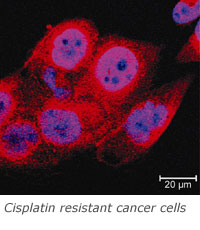|
Study Provides Clues about How Cancer Cells Develop Resistance to Chemotherapy Drug Researchers have shown that increased expression of a gene called SIRT1 in cancer cells plays a significant role in the development of resistance to the chemotherapy drug cisplatin. The SIRT1 gene, which regulates several important cellular processes including nutrient use and metabolism, appears to contribute to the development of cisplatin resistance by reducing the uptake and use of glucose by cells and by altering the function of their mitochondria, which are cellular structures that produce most of the energy in cells. These findings, by researchers at the National Cancer Institute (NCI), part of the National Institutes of Health (NIH), and colleagues, were published in the Sept. 15, 2008, issue of Molecular Cancer Research.
 Cisplatin, a chemotherapy drug that contains the metallic element platinum, is widely used in the treatment of many types of cancer, including bladder, lung, ovarian, and testicular cancer. It slows or stops the growth of cancer cells by binding to DNA. Tumors that recur after an initially positive response to treatment with cisplatin are frequently resistant to it, meaning the drug is no longer effective. Knowing more about how cells become resistant to cisplatin will enable researchers to devise strategies to circumvent resistance and increase the effectiveness of this important anticancer drug. Cisplatin, a chemotherapy drug that contains the metallic element platinum, is widely used in the treatment of many types of cancer, including bladder, lung, ovarian, and testicular cancer. It slows or stops the growth of cancer cells by binding to DNA. Tumors that recur after an initially positive response to treatment with cisplatin are frequently resistant to it, meaning the drug is no longer effective. Knowing more about how cells become resistant to cisplatin will enable researchers to devise strategies to circumvent resistance and increase the effectiveness of this important anticancer drug.
To investigate mechanisms that contribute to cisplatin resistance in cancer cells, the researchers generated cells that were resistant to the drug by exposing them to cisplatin in the laboratory. They found that expression of the SIRT1 gene increased three to five fold as the levels of cisplatin were increased, producing increasing levels of resistance in the cells. On the other hand, the researchers found that cisplatin-resistant cancer cells became more sensitive to the drug when the level of SIRT1 expression was reduced. By decreasing the levels of SIRT1 expression three to five fold, the cancer cells became approximately two fold more sensitive to cisplatin. "It appears that SIRT1 contributes to 50 percent of the cellular resistance to cisplatin, but it does not account for all of the resistance," said Michael Gottesman, M.D., of NCI's Center for Cancer Research, and an author of the study.
Many factors contribute to cisplatin resistance and may include mechanisms that limit cellular uptake of the drug, altered mechanisms that allow cells to repair damage to their DNA, and mechanisms that help cells survive. "This study is part of a larger effort by scientists to determine important cellular changes that cause cancer cells to become resistant to chemotherapy drugs," said Gottesman. "Different types of genetic mutations can occur during the development of cellular resistance to anticancer drugs. Therefore, the first step is to elucidate the genes that contribute to this resistance in tumors."
Previous research by this team and others has shown that cisplatin-resistant cells grow more slowly and demonstrate reduced uptake of certain substances, including nutrients such as glucose, than cells that are sensitive to the drug. It was also known that, as a survival strategy, tumors alter their metabolism when nutrients are scarce. In this study, the researchers found that cancer cells increased their expression of SIRT1 and became more resistant to cisplatin treatment as the level of glucose in their environment was reduced. They also found that the uptake of glucose in resistant cells was four to five fold less than in cells that were sensitive to cisplatin. Oxygen consumption, an indicator of glucose use and energy production, decreased by 30 percent to 60 percent compared to cisplatin-sensitive cells.
Because mitochondria use glucose and oxygen to produce energy, the team investigated the function of mitochondria in cisplatin-resistant cells. They found that, as cellular resistance to cisplatin increased, the potential of mitochondria to produce energy decreased, indicating that the metabolic role of mitochondria in resistant cells is different from that in cells that are sensitive to the drug. The researchers also found that the mitochondria of resistant cells were smaller and that the internal structures were irregular compared to the mitochondria of cells that were sensitive to the drug.
Gottesman and colleagues are developing molecular tools to define the drug-resistance genes that are expressed in individual cancers, and, in the future, hope to use this information to predict a patient's response to therapy and to design new ways to circumvent resistance.
In addition to NCI, researchers from the National Heart, Lung, and Blood Institute, part of the NIH; the U.S. Food and Drug Administration; and the National Center of Nanoscience and Technology, Beijing, People's Republic of China, participated in the study.
###
Liang X, Finkel T, Shen D, Yin J, Aszalos A., and Gottesman MM. SIRT1 Contributes in Part to Cisplatin Resistance in Cancer Cells by Altering Mitochondrial Metabolism. Molecular Cancer Research. September, 15, 2008.
For more information on Dr. Gottesman's research, please go to http://ccr.cancer.gov/staff/staff.asp?profileid=5713.
NCI leads the National Cancer Program and the NIH effort to dramatically reduce the burden of cancer and improve the lives of cancer patients and their families, through research into prevention and cancer biology, the development of new interventions, and the training and mentoring of new researchers. For more information about cancer, please visit the NCI Web site at http://www.cancer.gov or call NCI's Cancer Information Service at 1-800-4-CANCER (1-800-422-6237).
Back to Top |